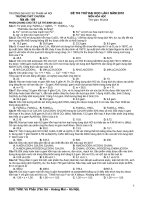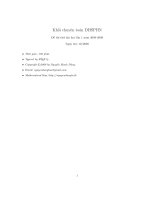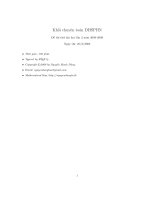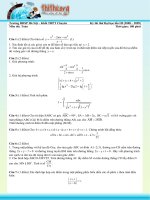đề thi thử đại học sư phạm
Bạn đang xem bản rút gọn của tài liệu. Xem và tải ngay bản đầy đủ của tài liệu tại đây (141.8 KB, 6 trang )
TRƯỜNG ĐHSP HÀ NỘI
TRƯỜNG THPT NGUYỄN TẤT THÀNH
Mã đề thi 209
ĐỀ THI THỬ ĐẠI HỌC LẦN THỨ 2
Năm học 2011 - 2012
MÔN THI : TIẾNG ANH
Thời gian làm bài: 90 phút (không kể thời gian giao đề)
Mark the letter A, B, C or D on your answer sheet to indicate the word that differs from the rest
in the position of the main stress in each of the following questions.
1. A. obliged B. photography C. partnership D. attribute
2. A. attitude B. sacrifice C. object D. precede
3. A. appropriate B. already C. apology D. artificial
4. A. regulatory B. dedicated C. mischievous D. confide
5. A. determine B. significant C. survey D. majority
Mark the letter A, B, C or D on your answer sheet to indicate the correct answer to each of the
following questions.
6. ‘Today’s my 21st birthday.’ ‘ _____________________ !’
A. It’s so good B. Many happy returns C. Take care D. Have a good time
7. ‘Don’t forget to send your parents my regards.’ ‘_____________________.’
A. It’s my pleasure B. Thanks, I will C. You’re welcome D. Good idea, I will
8. The government is expected to _____________________ steps against unemployment.
A. apply B. take C. use D. make
9. ‘Do you mind if I open the window ?’ ‘_____________________.’
A. Yes, it is B. Yes, of course C. I’d rather you didn’t D. Please, don’t worry
10. It was _____________________ film that few people stayed until the end of it.
A. a such boring B. such boring C. so a boring D. so boring a
11. On being told about her sack, _____________________.
A. All are correct B. her boss felt sorry for Marry
C. Marry’s face turned pale D. Marry was shocked
12. ‘I saw you in the library last night.’ ‘You _____________________ me; I wasn’t there.’
A. might not have seen B. didn’t see C. couldn’t see D. can’t have seen
13. Don’t worry. I have _____________________ tire at the back of my car.
A. the other B. another C. other D. others
14. I clearly remember _____________________ you about this before.
A. being told B. telling C. tell D. to tell
15. The home team managed to _____________________ the guest team in the last minute of the match.
A. beat B. invade C. gain D. win
16. The elderly tourists do not find the thought of climbing the hill _____________________.
A. appealed B. appeal C. unappealing D. appealing
17. I’ve been planning to sort out my files but I haven’t _____________________ yet.
A. got round to it B. got away with it C. managed doing it D. got at it
18. My _____________________ of life has changed a lot since leaving university.
A. opinions B. outlook C. attitude D. approach
19. But for his help, I _____________________.
A. did not succeed B. would not have succeeded C. had not succeeded D. would succeed
20. The teacher was worried about the play her young class was putting on for the parents but, fortunately,
everything _____________________ off without any problems.
A. passed B. walked C. took D. called
21. I’ve been feeling _____________________ tired lately, doctor.
A. much B. the most C. more and more D. such
1
22. _____________________ down to dinner than the telephone rang again.
A. No sooner I sat B. No sooner I sat C. No sooner had I sat D. No sooner have I sat
23. After the enormous dinner he had to _____________________ his belt.
A. broaden B. enlarge C. widen D. loosen
24. Janet’s doctor insists _____________________ for a few days.
A. her staying home B. she stays at home C. that she stay home D. that she stays home
25. The number of students getting good marks in their exams _____________________.
A. is going up B. is more and more C. are going forward D. are going up
Mark the letter A, B, C or D on your answer sheet to show the underlined part that needs
correction.
26. Some insects bear a remarkable resemblance to dead twigs, being long, slenderness, wingless, and brownish in
A B C D
colour.
27. Asteroids may be fragments of a planet shattered long ago or from material the nuclei of old comets.
A B C D
28. Had the committee members considered the alternatives more carefully, they would have realized that the
A B C
second was better the first.
D
29. Most of the production that like fruit and vegetables you find in this supermarket has been imported.
A B C D
30. The first Native Americans to occupy what is now the southwestern United States were the Big-Game Hunters,
A B C
which appeared about 10,000 B.C.
D
31. Although they reflect a strong social conscience, Arthur Miller’s stage works are typical more concerned with
A B C
individuals than with systems.
D
32. The importance of environmental stimuli in the development coordination between sensory input and motor
A B C
response varies to species to species.
D
33. In France people drive on the left, so sure you go on the right side.
A B C D
34. Most sand dunes are always in motion as wind pushes sand upward one side of each dune, over the top, and
A B C
down the other side.
D
35. Today, modern textile mills can manufacture as much fabrics in a few seconds as it once took workers weeks to
A B C D
produce by hand.
Read the following passage and mark the letter A, B, C or D on your answer sheet to indicate the
correct word for each of the blanks from 36 to 50.
DINOSAUR DISCOVERIES
In the late 1930s, a group of (36) ___________ American scientists seeking dinosaur fossils made some
noteworthy (37) ___________. Although one of their expeditions discovered no fossils, it nonetheless historic
expedition, which took place along the (39) ___________ of the Paluxy river in Texas, something extraordinary
was revealed : a dinosaur track, clearly (40) ___________ in the rock. These dinosaur footprints (41) ___________
2
their preservation to the salts and mud that covered them and then hardened into rock, before (42) ___________ to
light 100 million years later. Tracks like these are (43) ___________ to experts. There have been great gaps in
scientists’ understanding of dinosaur (44) ___________, and so such footprints are useful since they provide direct
(45) ___________ of how dinosaurs actually moved. Scientists have used these and (46) ___________ footprints to
determine how quickly different species walked, concluding that many kinds of dinosaur must have travelled in
(47) ___________.
(48) ___________, the tracks of four-legged dinosaurs seem to (49) ___________ that, in spite of being
reptiles, these creatures must have moved in a very similar way to living mammals, such as elephants - a pattern of
movement (50) ___________ from that of most contemporary reptiles, such as crocodiles. This leads to an
interesting question. Might existing mammals have more to teach us about the extinct reptiles that once walked the
earth ?
36. A. dominant B. primary C. principal D. leading
37. A. observation B. finds C. finding D. surveys
38. A. turned B. arose C. proved D. occurred
39. A. banks B. borders C. verges D. coasts
40. A. distinguishable B. blatant C. ostensible D. substantial
41. A. thank B. result C. owe D. derive
42. A. coming B. bringing C. surfacing D. appearing
43. A. costly B. rare C. invaluable D. unique
44. A. manners B. action C. customs D. behavior
45. A. evidence B. source C. support D. basis
46. A. different B. the others C. other D. another
47. A. bunches B. herds C. sets D. masses
48. A. Alternatively B. Interestingly C. Characteristically D. Appropriately
49. A. indicate B. specify C. express D. point
50. A. unconnected B. detached C. separate D. distinct
Mark the letter A, B, C or D on your answer sheet to indicate the sentence that is closest in
meaning to each of the following questions.
51. It’s too late to change it, so leave it the way it is.
A. We can’t leave it the way it is. B. It can’t be altered at this point.
C. We should change it before we leave. D. We should change it before it is too late.
52. I can’t help feeling worried about Jim.
A. I can do nothing to help Jim. B. I find it impossible not to worry about Jim.
C. I don’t worry about Jim. D. I cannot help Jim stop worrying.
53. Slightly more than twenty-five percent of the students in the class come from Spanish-speaking countries.
A. Seventy-five percent of the students in the class speak Spanish.
B. A considerable proportion of the students in the class are Spanish.
C. A small minority of the students in the class are Hispanic.
D. The percentage of the students speaking Spanish fell by twenty-five percent.
54. ‘Stop smoking or you’ll be ill,’ the doctor told me.
A. I was warned against smoking a lot of cigarettes.
B. The doctor advised me to give up smoking to avoid illness.
C. The doctor suggested smoking to treat illness.
D. I was ordered not to smoke to recover from illness.
55. Most people get fewer colds in the summer than in the winter.
A. People get colder in the summer than in the winter.
B. A person is more likely to get a cold in the winter than in the summer.
C. More people have summer colds than winter colds.
D. The winter is much colder than the summer.
3
Read the following passage and mark the letter A, B, C or D on your answer sheet to indicate the
correct answer to each of the questions from 56 to 63.
The immune system is equal in complexity to the combined intricacies of the brain and nervous system. The
success of the immune system in defending the body relies on a dynamic regulatory communications network
consisting of millions and millions of cells. Organized into sets and subsets, these cells pass information back and
forth like clouds of bees swarming around a hive. The result is a sensitive system of checks and balances that
produces an immune response that is prompt, appropriate, effective, and self-limiting.
At the heart of the immune system is the ability to distinguish between self and non-self. When immune
defenders encounter cells or organisms carrying foreign or non-self molecules, the immune troops move quickly to
eliminate the intruders. Virtually every body cell carries distinctive molecules that identify it as self. The body’s
immune defenses do not normally attack issues that carry self-markers. Rather, immune cells and other body cells
coexist peaceably in a state known as self-tolerance. When a normally functioning immune system attacks a non-
self molecule, the system has the ability to remember the specifics of the foreign body. Upon subsequent encounters
with the same species of molecules, the immune system reacts accordingly. With the possible exception of
antibodies passed during lactation, this so-called immune system memory is not inherited. Despite the occurrence
of a virus in your family, your immune system must learn from experience with the many millions of distinctive
non-self molecules in the sea of microbes in which we live. Learning entails producing the appropriate molecules
and cells to match up with and counteract each non-self invader.
Any substance capable of triggering an immune response is called an antigen. Antigens are not to be
confused with allergens, which are most often harmless substances (such as ragweed pollen or cat hair) that
provoke the immune system to set off the inappropriate and harmful response known as allergy. An antigen can be a
virus, a bacterium, a fungus, a parasite, or even a portion or product of one of these organisms. Tissues or cells from
another individual (except an identical twin, whose cells carry identical self markers) also act as antigens; because
the immune system recognizes transplanted tissues as foreign, it rejects them. The body will even reject nourishing
proteins unless they are first broken down by the digestive system into their primary, non-antigenic building blocks.
An antigen announces its foreignness by means of intricate and characteristic shapes called epitopes, which
protrude from its surface. Most antigens, even the simplest microbes, carry different kinds of epitopes on their
surface; some may even carry several hundred. Some epitopes will be more effective than others at stimulating an
immune response. Only in abnormal situations does the immune system wrongly identify self as non-self and
execute a misdirected immune attack. The result can be so-called autoimmune disease such as rheumatoid arthritis
or systemic lupus erythematosis. The painful side effects of these diseases are caused by a person’s immune system
actually attacking itself.
56. After you have had the chicken pox, your immune system will be able to do all of the following EXCEPT
__________.
A. prevent your offspring from infection by the chicken pox virus
B. remember previous experiences with the chicken pox virus
C. match up and counteract non-self molecules in the form of the chicken pox virus
D. distinguish between your body cells and that of the chicken pox virus
57. Which of the following best expresses the main idea of this passages ?
A. The human body presents an opportune habitat for microbes.
B. One of the immune system’s primary functions is the allergic response.
C. An antigen is any substance that triggers an immune response.
D. The basic function of the immune system is to distinguish between self and non-self.
58. Why would tissue transplanted from father to daughter have a greater risk of being detected as foreign than a
tissue transplanted between identical twins ?
A. The age of the twins’ tissue would be the same and, therefore, less likely to be rejected.
B. The identical twins’ tissue would carry the same self-markers and would, therefore, be less likely to be rejected.
C. The twins’ immune systems would remember the same encounters with childhood illnesses.
D. The difference in the sex of the father and daughter would cause the tissue to be rejected by the daughter’s
immune system.
4
59. What is the meaning of the underlined word ‘intricacies’ as it is used in the first sentence of the passage ?
A. elaborate interconnections B. comprehensive coverage
C. inherent perplexity D. confusion of pathways
60. What is the specific term for the substance capable of triggering an inappropriate or harmful immune response
to a harmless substance such as ragweed pollen ?
A. microbe B. antigen C. allergen D. autoimmune disease
61. How do the cells in the immune system recognize an antigen as foreign or non-self ?
A. through an allergic response B. through blood type
C. through fine hairs protruding from the antigen surface D. through characteristic shapes on the antigen surface
62. The immune cells and other cells in the body coexist peaceably in a state known as __________.
A. self-tolerance B. harmony C. tolerance D. equilibrium
63. What is the analogy used to describe the communications network among the cells in the immune system ?
A. A sea of microbes B. The immune system’s memory
C. Bees swarming around a hive D. Immune troops eliminating intruders
Read the following passage and mark the letter A, B, C or D on your answer sheet to indicate the
correct answer to each of the questions from 64 to 69.
For centuries, time was measured by the position of the sun with the use of sundials. Noon was recognized
when the sun was the highest in the sky, and cities would set their clock by this apparent solar time, even though
some cities would often be on a slightly different time. Daylight Saving Time (DST), sometimes called summer
time, was instituted to make better use of daylight. Thus, clocks are set forward on hour in the spring to move an
hour of daylight from the morning to the evening and then set back one hour in the fall to return to normal daylight.
Benjamin Franklin first conceived the idea of daylight saving during his tenure as an American delegated in
Paris in 1984 and wrote about it extensively in his essay, “An Economical Project”. It is said that Franklin awoke
early one morning and was surprised to see the sunlight at such an hour. Always the economist, Franklin believed
the practice of moving the time could save on the use of candlelight, as candles were expensive at the time.
In England, builder William Willett (1857 - 1915) became a strong supporter for Daylight Saving Time upon
noticing blinds of many houses were closed on an early sunny morning. Willett believed everyone, including
himself, would appreciate longer hours of light in the evenings. In 1909, Sir Robert Pearce introduced a bill in the
House of Commons to make it obligatory to adjust the clocks. A bill was drafted an introduced into Parliament
several times but met with great opposition, mostly from farmers. Eventually, in 1925, it was decided that summer
time should begin on the day following the third Saturday in April and close after the first Saturday in October.
The U.S Congress passed the Standard Time Act of 1918 to establish standard time and preserve and set
Daylight Saving Time across the continent. This act also devised five time zones throughout the United States :
Eastern, Central, Mountain, Pacific, and Alaska. The first time zone was set on “the mean astronomical time of the
seventy-fifth degree of longitude west from Greenwich” (England). In 1919, this act was repealed.
President Roosevelt establish year-round Daylight Saving Time (also called War Time) form 1942-1945.
However, after this period, each state adopted its own DST, which proved to be disconcerting to television and
radio broadcasting and transportation. In 1966, President Lyndon Johnson created the Department of Transportation
and signed the Uniform Time Act. As a result, the Department of Transportation was given the responsibility for the
time laws. During the old embargo and energy crisis of the 1970s, President Richard Nixon extended DST through
the Daylight Saving Time Energy Act of 1973 to conserve energy further. This law was modified in 1986, and
Daylight Saving Time was reset to begin on the first Sunday in April (to spring ahead) and end on the last Sunday in
October (to fall back).
64. Which of the following statements is true of the U.S Department of Transportation ?
A. It constructed the Uniform Time Act. B. It was created by President Richard Nixon.
C. It oversees all time laws in the United States. D. It set standards for DST throughout the world.
65. Which of the following would be the best title for this passage ?
A. Lyndon Johnson and the Uniform Time Act.
B. The U.S Department of Transportation and Daylight for this passage ?
C. The History and Rationale of Daylight Saving Time
5
D. Daylight Saving Time in the United States
66. As it is used in paragraph 3, the word ‘obligatory’ most nearly means ____________.
A. approved B. requisite C. aberrant D. sparse
67. Who opposed the bill that was introduced in the House of Commons in the early 1980s ?
A. farmers B. the U. S Congress
C. Sir Robert Pearce D. television and radio broadcasting companies
68. Who first established the idea of DST ?
A. Benjamin Franklin B. President Lyndon Johnson C. President Richard Nixon D. Sir Robert Pearce
69. The Daylight Saving Time Energy Act of 1973 was responsible for ____________.
A. preserving and setting Daylight Saving Time across the continent
B. instituting five time zones in the United States
C. extending Daylight Saving Time in the interest of energy conservation
D. conserving energy by giving the Department of Transportation authority over time laws
Read the following passage and mark the letter A, B, C or D on your answer sheet to indicate the
correct word for each of the blanks from 70 to 80.
GIRLS AND TECHNOLOGY
If you want your daughter to succeed, buy her a toy construction set. That is the advice from Britain’s (70)
___________ female engineers and scientists. Marie-Noelle Barton, who heads an Engineering Council campaign
to encourage girls into science and engineering, maintains that some of Britain’s most successful women have had
their careers (71) ___________ by the toys they played with as children. Even girls who end (72) ___________
nowhere near a microchip or microscope could benefit from a better (73) ___________ of science and technology.
‘It’s a (74) ___________ of giving them experience and confidence with technology so that when they are
(75) ___________ with a situation requiring some technical known-how, they feel they can handle it and don’t just
(76) ___________ defeat immediately’, says Mrs. Barton. ‘I believe that lost of girls feel unsure of themselves
when it comes (77) ___________ technology and therefore they might be losing out on jobs because they are
reluctant even to apply for them.’
Research recently carried out suggests that scientific and constructional toys should be (78) ___________ to
girls from an early age, otherwise the result is ‘socialization’ into stereotypical female (79) ___________, which
may explain why relatively few girls study science and engineering at university in Britain. Only 14% of those who
have gone for engineering (80) ___________ at university this year are women, although this figure does represent
an improvement of the 7% recorded some years ago.
70. A. predominant B. foremost C. surpassing D. uppermost
71. A. styled B. shaped C. built D. modeled
72. A. by B. in C. up D. on
73. A. insight B. hold C. realization D. grasp
74. A. situation B. state C. matter D. cause
75. A. presented B. encountered C. approached D. offered
76. A. allow B. receive C. admit D. permit
77. A. to B. with C. from D. for
78. A. feasible B. reachable C. obtainable D. accessible
79. A. roles B. characters C. parts D. states
80. A. alternatives B. selections C. preferences D. options
6









